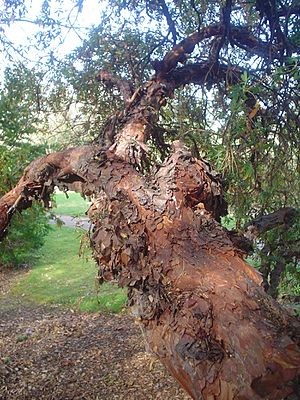Polylepis australis facts for kids
Quick facts for kids Polylepis australis |
|
|---|---|
 |
|
| Scientific classification | |
| Genus: |
Polylepis
|
| Species: |
australis
|
Polylepis australis, also called tabaquillo or queñoa, is a special tree found only in central Argentina. It belongs to the Rosaceae family, which includes plants like roses. The Polylepis group of trees first grew in the eastern Andes mountains of South America.
What Does It Look Like?
This tree has small leaves that are 7 to 10 centimeters long. Each leaf is made up of five or seven smaller leaflets, arranged like a feather. When winter gets very cold, Polylepis australis protects itself. It grows loose, papery bark that peels off in rolls. This brownish bark helps the tree survive the harsh weather.
Where Does It Grow?
Polylepis australis naturally grows in the Sierras Pampeanas. These are mountain ranges that run north to south on the eastern side of the Andes in north-central Argentina. You can find it in provinces like Catamarca, Córdoba, Jujuy, Salta, and Tucumán. It usually grows in high-up forests and woodlands, from about 1,200 to 2,900 meters above sea level.
The trees found furthest south are in the high Córdoba Mountains of central Argentina. These mountains are between 1,200 and 2,884 meters high.
Why Is It Important?
The Polylepis mountain forests in South America are some of the most endangered forest ecosystems in the world. This means they are at high risk of disappearing.
Scientists are working to help these trees. For example, D. Renison from the National University of Córdoba in Argentina studied how Polylepis australis seeds grow. He found that fewer seeds sprout when there are fewer trees around. This shows how important it is to have healthy forests.
Other studies, done with Isabell Hensen from the University of Halle in Germany, found something interesting. The more people affect a forest, the less likely Polylepis australis seeds are to grow. This means human activities can harm the trees.
Scientists also learned that the seeds of Polylepis australis can be very different. Their size and how well they sprout can change a lot. This depends on the individual tree and where it grows. These studies help experts understand how to protect and regrow these important forests.
Gallery
See also
 In Spanish: Polylepis australis para niños
In Spanish: Polylepis australis para niños











